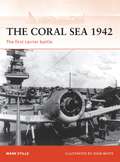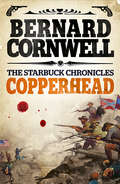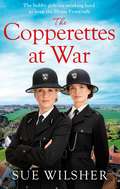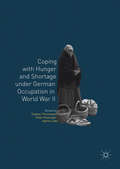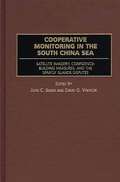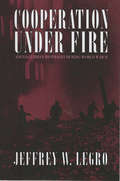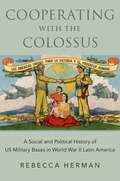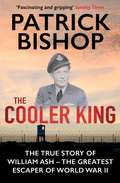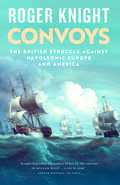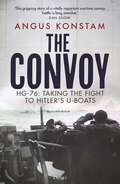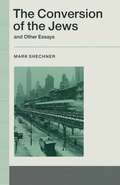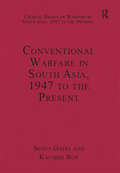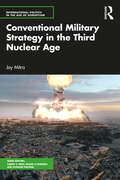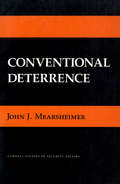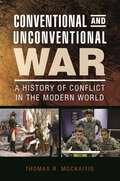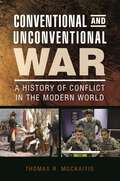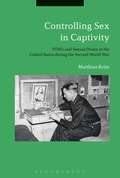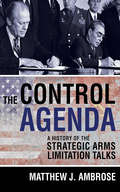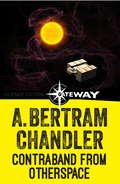- Table View
- List View
The Coral Sea 1942: The first carrier battle (Campaign)
by John White Mark StilleThe Battle of the Coral Sea is unique in the annals of naval history. It is the first battle in which enemy fleets never came within sight of one another. Instead, aircraft launched from carrier decks were sent out to attack the enemy with bombs and torpedoes. In May of 1942, the Japanese fleet moved on Port Moresby, the last Allied base between Australia and Japan. Forced to respond, the Americans sent two aircraft carriers to protect the base. In the ensuing battle, one American carrier was destroyed and the other severely damaged. However, the Japanese also lost a carrier and decided to withdraw. Although bloody, it proved to be an important strategic victory for the Allies as the Japanese were forced to attempt future attacks on Port Moresby over land. Using the latest research and numerous period photographs, retired USN Commander Mark O Stille tells the story of this important and unique battle in the Pacific War.
Copperhead (The Starbuck Chronicles #2)
by Bernard CornwellThe second book in Bernard Cornwell’s bestselling series on the American Civil War.
The Copperettes at War
by Sue WilsherEssex, 1918Aggie has tasted freedom working at the local munitions factory. But the Great War is coming to an end, and the men are coming home. Aggie can't bear the idea of going back into service. She wants more from her life - and becoming a Copperette - a member of the Women's Police Service - might help her move up in the world.Mim just wants to do her bit for her country. She's prepared to work hard to help her fellow women and keep up morale. She even takes Aggie in to her house to help with her training. Mim and Aggie face shocking loss even in the last days of the war. But will they find a way to work together?
Coping with Hunger and Shortage under German Occupation in World War II (PDF)
by Tatjana Tönsmeyer Peter Haslinger Agnes LabaThis volume demonstrates how German expansion in the Second World War II led to shortages, of food and other necessities including medicine, for the occupied populations, causing many to die from severe hunger or starvation. While the various chapters look at a range of topics, the main focus is on the experiences of ordinary people under occupation; their everyday life, and how this quickly became dominated by the search for supplies and different strategies to fight scarcity. The book discusses various such strategies for surviving increasingly catastrophic circumstances, ranging from how people dealt with rationing systems, to the use of substitute products and recycling, barter, black-marketeering and smuggling, and even survival prostitution. In addressing examples from Norway to Greece and from France to Russia, this volume offers the first pan-European perspective on the history of shortage, malnutrition and hunger resulting from the war, occupation, and aggressive German exploitation policies.
Coping with Hunger and Shortage under German Occupation in World War II
by Tatjana Tönsmeyer Peter Haslinger Agnes LabaThis volume demonstrates how German expansion in the Second World War II led to shortages, of food and other necessities including medicine, for the occupied populations, causing many to die from severe hunger or starvation. While the various chapters look at a range of topics, the main focus is on the experiences of ordinary people under occupation; their everyday life, and how this quickly became dominated by the search for supplies and different strategies to fight scarcity. The book discusses various such strategies for surviving increasingly catastrophic circumstances, ranging from how people dealt with rationing systems, to the use of substitute products and recycling, barter, black-marketeering and smuggling, and even survival prostitution. In addressing examples from Norway to Greece and from France to Russia, this volume offers the first pan-European perspective on the history of shortage, malnutrition and hunger resulting from the war, occupation, and aggressive German exploitation policies.
Cooperative Monitoring in the South China Sea: Satellite Imagery, Confidence-Building Measures, and the Spratly Islands Disputes
by John C. Baker David G. WiencekThe Spratly Islands have represented a potential political and military flashpoint in the South China Sea for years, involving as they do various claims by China, the Philippines, Vietnam, Malaysia, and Taiwan. This edited volume examines the issues involved in light of confidence- building measures that new high-resolution satellite imagery can offer to this, and other, regions.Baker, Wiencek, and their contributors assess the potential role for cooperative monitoring in mitigating the risk of conflict arising from multinational disputes over the Spratly Islands. They analyze how this new generation of civilian and commercial observation satellites can be used to reduce the changes of armed conflict breaking out by providing transparency that will detect and identify politically significant activities occurring at disputed islands and reefs among the Spratlys. Of particular interest to policy makers, scholars, and other researchers involved with military issues in Asia and international security concerns.
Cooperation under Fire: Anglo-German Restraint during World War II (Cornell Studies in Security Affairs)
by Jeffrey W. LegroWhy do nations cooperate even as they try to destroy each other? Jeffrey Legro explores this question in the context of World War II, the "total" war that in fact wasn't. During the war, combatant states attempted to sustain agreements limiting the use of three forms of combat considered barbarous—submarine attacks against civilian ships, strategic bombing of civilian targets, and chemical warfare. Looking at how these restraints worked or failed to work between such fierce enemies as Hitler's Third Reich and Churchill's Britain, Legro offers a new understanding of the dynamics of World War II and the sources of international cooperation.While traditional explanations of cooperation focus on the relations between actors, Cooperation under Fire examines what warring nations seek and why they seek it—the "preference formation" that undergirds international interaction. Scholars and statesmen debate whether it is the balance of power or the influence of international norms that most directly shapes foreign policy goals. Critically assessing both explanations, Legro argues that it was, rather, the organizational cultures of military bureaucracies—their beliefs and customs in waging war—that decided national priorities for limiting the use of force in World War II.Drawing on documents from Germany, Britain, the United States, and the former Soviet Union, Legro provides a compelling account of how military cultures molded state preferences and affected the success of cooperation. In its clear and cogent analysis, this book has significant implications for the theory and practice of international relations.
Cooperating with the Colossus: A Social and Political History of US Military Bases in World War II Latin America
by Rebecca HermanDuring the Second World War, the United States built over two hundred defense installations on sovereign soil in Latin America in the name of cooperation in hemisphere defense. Predictably, it proved to be a fraught affair. Despite widespread acclaim for Pan-American unity with the Allied cause, defense construction incited local conflicts that belied the wartime rhetoric of fraternity and equality. Cooperating with the Colossus reconstructs the history of US basing in World War II Latin America, from the elegant chambers of the American foreign ministries to the cantinas, courtrooms, plazas, and brothels surrounding US defense sites. Foregrounding the wartime experiences of Brazil, Cuba, and Panama, the book considers how Latin American leaders and diplomats used basing rights as bargaining chips to advance their nation-building agendas with US resources, while limiting overreach by the "Colossus of the North" as best they could. Yet conflicts on the ground over labor rights, discrimination, sex, and criminal jurisdiction routinely threatened the peace. Steeped in conflict, the story of wartime basing certainly departs from the celebratory triumphalism commonly associated with this period in US-Latin American relations, but this book does not wholly upend the conventional account of wartime cooperation. Rather, the history of basing distills a central tension that has infused regional affairs since a wave of independence movements first transformed the Americas into a society of nations: national sovereignty and international cooperation may seem like harmonious concepts in principle, but they are difficult to reconcile in practice. Drawing on archival research in five countries, Cooperating with the Colossus is a revealing history told at the local, national, and international levels of how World War II transformed power and politics in the Americas in enduring ways.
Cooperating with the Colossus: A Social and Political History of US Military Bases in World War II Latin America
by Rebecca HermanDuring the Second World War, the United States built over two hundred defense installations on sovereign soil in Latin America in the name of cooperation in hemisphere defense. Predictably, it proved to be a fraught affair. Despite widespread acclaim for Pan-American unity with the Allied cause, defense construction incited local conflicts that belied the wartime rhetoric of fraternity and equality. Cooperating with the Colossus reconstructs the history of US basing in World War II Latin America, from the elegant chambers of the American foreign ministries to the cantinas, courtrooms, plazas, and brothels surrounding US defense sites. Foregrounding the wartime experiences of Brazil, Cuba, and Panama, the book considers how Latin American leaders and diplomats used basing rights as bargaining chips to advance their nation-building agendas with US resources, while limiting overreach by the "Colossus of the North" as best they could. Yet conflicts on the ground over labor rights, discrimination, sex, and criminal jurisdiction routinely threatened the peace. Steeped in conflict, the story of wartime basing certainly departs from the celebratory triumphalism commonly associated with this period in US-Latin American relations, but this book does not wholly upend the conventional account of wartime cooperation. Rather, the history of basing distills a central tension that has infused regional affairs since a wave of independence movements first transformed the Americas into a society of nations: national sovereignty and international cooperation may seem like harmonious concepts in principle, but they are difficult to reconcile in practice. Drawing on archival research in five countries, Cooperating with the Colossus is a revealing history told at the local, national, and international levels of how World War II transformed power and politics in the Americas in enduring ways.
The Cooler King: The True Story of William Ash - The Greatest Escaper of World War II
by Patrick BishopA thrilling tale of incredible courage and resilience, a true wartime story of William Ash.The Cooler King is at once uplifting and inspirational, and stands as a testament to the durability of decent values and the invincible spirit of liberty.The Cooler King tells the astonishing story of William Ash, an American flyer brought up in Depression-hit Texas, who after being shot down in his Spitfire over France in early 1942 spent the rest of the war defying the Nazis by striving to escape from every prisoner of war camp in which he was incarcerated. Alongside William Ash is a cast of fascinating characters, including Douglas Bader, Roger Bushell, who would go on to lead the Great Escape, and Paddy Barthropp, a dashing Battle of Britain pilot who despite his very different background became Ash's best friend and shared many of his adventures. Using contemporary documents and interviews with Ash's comrades, Patrick Bishop vividly recreates the multiple escape attempts, while also examining the P.O.W. experience and analysing the passion that drove some prisoners to risk death in repeated bids for freedom.
Convoys: The British Struggle Against Napoleonic Europe and America
by Roger KnightThe first account of Britain’s convoys during the Napoleonic Wars—showing how the protection of trade played a decisive role in victory During the Napoleonic Wars thousands of merchant ships crisscrossed narrow seas and wide oceans, protected by Britain’s warships. These were wars of attrition and raw materials had to reach their shores continuously: timber and hemp from the Baltic, sulfur from Sicily, and saltpeter from Bengal. Britain’s fate rested on the strength of its economy—and convoys played a vital role in securing victory. Leading naval historian Roger Knight examines how convoys ensured the protection of trade and transport of troops, allowing Britain to take the upper hand. Detailing the many hardships these ships faced, from the shortage of seaman to the vicissitudes of the weather, Knight sheds light on the innovation and seamanship skills that made convoys such an invaluable tool in Britain’s arsenal. The convoy system laid the foundation for Britain’s narrow victory over Napoleon and his allies in 1815 and, in doing so, established its naval and mercantile power at sea for a hundred years.
The Convoy: HG-76: Taking the Fight to Hitler's U-boats
by Angus KonstamThe Convoy represents a fresh approach to the story of the Battle of the Atlantic. It is also the first to deal with the more spectacular story of HG-76, a major turning point in the naval war.HG-76 sailed from Gibraltar to Britain in December 1941 and was specially targeted by the Germans. A wolfpack of U-boats was sent against it, and the Luftwaffe was heavily committed too in a rare example of German inter-service cooperation. German intelligence agents in Gibraltar and Spain also knew every detail of HG-76 before it had even sailed, seemingly stacking the odds in favour of the Kriegsmarine. Despite this the convoy fought its way through. Improved radar and sonar gave the convoy's escorts a slight edge over their opponents, while the escort group was led by Commander Walker, an anti-submarine expert who had developed new, aggressive U-boat hunting tactics. Previous Gibraltar convoys had been mauled by Luftwaffe bombers operating from French airfields. This time, though, HG-76 would be accompanied by HMS Audacity, the Royal Navy's first escort carrier – a new type of warship purpose-built to defend convoys from enemy aircraft and U-boats. Following seven days and nights of relentless attack, the horrors of which are brought home through a series of first-hand accounts, the convoy finally reached the safety of a British port for the loss of only two merchant ships. Its arrival was seen as the first real convoy victory of the war. Brought to life by expert naval historian Angus Konstam, The Convoy combines the story of the technical and tactical developments that won the Battle of the Atlantic for the Allies along with a narrative that reveals both the terror and the stubborn determination that defined the experiences of those that served on convoy duties.
The Convoy: HG-76: Taking the Fight to Hitler's U-boats
by Angus KonstamThe Convoy represents a fresh approach to the story of the Battle of the Atlantic. It is also the first to deal with the more spectacular story of HG-76, a major turning point in the naval war.HG-76 sailed from Gibraltar to Britain in December 1941 and was specially targeted by the Germans. A wolfpack of U-boats was sent against it, and the Luftwaffe was heavily committed too in a rare example of German inter-service cooperation. German intelligence agents in Gibraltar and Spain also knew every detail of HG-76 before it had even sailed, seemingly stacking the odds in favour of the Kriegsmarine. Despite this the convoy fought its way through. Improved radar and sonar gave the convoy's escorts a slight edge over their opponents, while the escort group was led by Commander Walker, an anti-submarine expert who had developed new, aggressive U-boat hunting tactics. Previous Gibraltar convoys had been mauled by Luftwaffe bombers operating from French airfields. This time, though, HG-76 would be accompanied by HMS Audacity, the Royal Navy's first escort carrier – a new type of warship purpose-built to defend convoys from enemy aircraft and U-boats. Following seven days and nights of relentless attack, the horrors of which are brought home through a series of first-hand accounts, the convoy finally reached the safety of a British port for the loss of only two merchant ships. Its arrival was seen as the first real convoy victory of the war. Brought to life by expert naval historian Angus Konstam, The Convoy combines the story of the technical and tactical developments that won the Battle of the Atlantic for the Allies along with a narrative that reveals both the terror and the stubborn determination that defined the experiences of those that served on convoy duties.
The Conversion of the Jews and Other Essays: (pdf) (New Directions In American Studies)
by Mark ShechnerConventional Warfare in South Asia, 1947 to the Present (Critical Essays on Warfare in South Asia, 1947 to the Present)
by Kaushik RoyThe essays included in this volume focus on conventional war on land, sea and air fought by the states of South Asia and their impact on the host societies and economies. The authors are drawn from academia and the military in India and Pakistan, as well as from outside the subcontinent in order to give a wide perspective. In the introduction the editors describe the changing contours of warfare in South Asia, and the similarities and dissimilarities with warfare in the Middle East and South East Asia. The volume highlights the influence of extra-regional powers like China, Russia and the US in providing arms, munitions and shaping the texture of military doctrines and force structures of the South Asian powers.
Conventional Warfare in South Asia, 1947 to the Present (Critical Essays on Warfare in South Asia, 1947 to the Present)
by Kaushik RoyThe essays included in this volume focus on conventional war on land, sea and air fought by the states of South Asia and their impact on the host societies and economies. The authors are drawn from academia and the military in India and Pakistan, as well as from outside the subcontinent in order to give a wide perspective. In the introduction the editors describe the changing contours of warfare in South Asia, and the similarities and dissimilarities with warfare in the Middle East and South East Asia. The volume highlights the influence of extra-regional powers like China, Russia and the US in providing arms, munitions and shaping the texture of military doctrines and force structures of the South Asian powers.
Conventional Military Strategy in the Third Nuclear Age (International Politics in the Age of Disruption)
by Joy MitraThis volume delves into the way conventional deterrence operates between nuclear-armed states in the third nuclear age. Unlike the first and second ages the advent of this new age has witnessed greater strain on the principles of mutual vulnerability and survivability that may result in increased risks of advertent or inadvertent escalation and horizontal nuclear proliferation. The book looks at the sum of three key simultaneous developments in the third nuclear age that merit attention. These include the emergence of asymmetric strategies, the introduction of unmanned platforms and the expansion of nuclear arsenals. The volume discusses how these concurrent developments might shape the practice of conventional deterrence and provides useful insights into conventional military dynamics, not just among the current nuclear dyads but also ones that may emerge in future. It seeks answers to several key issues in state security not limited to — • What purpose and scope does the conventional military instrument have in a state’s overall military strategy versus other nuclear-armed states? • If mutual vulnerability and deterrence are the frameworks, why did the prospect of escalation appear in the first place? • What are the trends — political, doctrinal, or technological — that augment or diminish conventional and nuclear interface? With insights on military crises that have witnessed participation from nuclear-armed states like the United States, Russia, China, Pakistan, and India this book will especially be of interest to scholars and researchers working in the areas of security and deterrence studies, defence and strategic studies, peace and conflict studies, and foreign policy. It will also appeal to policymakers, career bureaucrats, security and defense practitioners, and professionals working with think tanks and embassies.
Conventional Military Strategy in the Third Nuclear Age (International Politics in the Age of Disruption)
by Joy MitraThis volume delves into the way conventional deterrence operates between nuclear-armed states in the third nuclear age. Unlike the first and second ages the advent of this new age has witnessed greater strain on the principles of mutual vulnerability and survivability that may result in increased risks of advertent or inadvertent escalation and horizontal nuclear proliferation. The book looks at the sum of three key simultaneous developments in the third nuclear age that merit attention. These include the emergence of asymmetric strategies, the introduction of unmanned platforms and the expansion of nuclear arsenals. The volume discusses how these concurrent developments might shape the practice of conventional deterrence and provides useful insights into conventional military dynamics, not just among the current nuclear dyads but also ones that may emerge in future. It seeks answers to several key issues in state security not limited to — • What purpose and scope does the conventional military instrument have in a state’s overall military strategy versus other nuclear-armed states? • If mutual vulnerability and deterrence are the frameworks, why did the prospect of escalation appear in the first place? • What are the trends — political, doctrinal, or technological — that augment or diminish conventional and nuclear interface? With insights on military crises that have witnessed participation from nuclear-armed states like the United States, Russia, China, Pakistan, and India this book will especially be of interest to scholars and researchers working in the areas of security and deterrence studies, defence and strategic studies, peace and conflict studies, and foreign policy. It will also appeal to policymakers, career bureaucrats, security and defense practitioners, and professionals working with think tanks and embassies.
Conventional Deterrence (Cornell Studies in Security Affairs)
by John J. MearsheimerConventional Deterrence is a book about the origins of war. Why do nations faced with the prospect of large-scale conventional war opt for or against an offensive strategy? John J. Mearsheimer examines a number of crises that led to major conventional wars to explain why deterrence failed. He focuses first on Allied and German decision making in the years 1939–1940, analyzing why the Allies did not strike first against Germany after declaring war and, conversely, why the Germans did attack the West. Turning to the Middle East, he examines the differences in Israeli and Egyptian strategic doctrines prior to the start of the major conventional conflicts in that region. Mearsheimer then critically assays the relative strengths and weaknesses of NATO and the Warsaw Pact to determine the prospects for conventional deterrence in any future crisis. He is also concerned with examining such relatively technical issues as the impact of precision-guided munitions (PGM) on conventional deterrence and the debate over maneuver versus attrition warfare.Mearsheimer pays considerable attention to questions of military strategy and tactics. Challenging the claim that conventional detrrence is largely a function of the numerical balance of forces, he also takes issue with the school of thought that ascribes deterrence failures to the dominance of "offensive" weaponry. In addition to examining the military consideration underlying deterrence, he also analyzes the interaction between those military factors and the broader political considerations that move a nation to war.
Conventional and Unconventional War: A History of Conflict in the Modern World
by Thomas R. MockaitisThis volume offers a comprehensive history of warfare since 1648, covering conventional and unconventional operations and demonstrating how most modern wars have been hybrid affairs that involved both. The book uses a broad range of conflicts to explore the societal forces that have shaped wars.Written by noted military historian Thomas R. Mockaitis, this book explores conventional and unconventional conflicts and considers the relationships between them. It considers how epic struggles like the American Civil War, World Wars I and II, and the conflicts in the Middle East, among many others, shaped human history. The coverage serves to highlight four themes: the relationship between armed forces and the societies that create them; the impact of technology (not just armaments) on warfare; the role of ideas and attitudes towards violence in determining why and how wars are fought; and the relationship between conventional and unconventional operations.The book also covers the advent and evolution of unconventional warfare, including counterinsurgency, the War on Terror, and current conflicts in the Middle East. It concludes with consideration of the forms armed conflict will take in the future. The book includes valuable excerpts from the writings of military thinkers such as Clausewitz and Sun Tzu, an extensive bibliography of primary and secondary sources, and supporting maps and diagrams.
Conventional and Unconventional War: A History of Conflict in the Modern World
by Thomas R. MockaitisThis volume offers a comprehensive history of warfare since 1648, covering conventional and unconventional operations and demonstrating how most modern wars have been hybrid affairs that involved both. The book uses a broad range of conflicts to explore the societal forces that have shaped wars.Written by noted military historian Thomas R. Mockaitis, this book explores conventional and unconventional conflicts and considers the relationships between them. It considers how epic struggles like the American Civil War, World Wars I and II, and the conflicts in the Middle East, among many others, shaped human history. The coverage serves to highlight four themes: the relationship between armed forces and the societies that create them; the impact of technology (not just armaments) on warfare; the role of ideas and attitudes towards violence in determining why and how wars are fought; and the relationship between conventional and unconventional operations.The book also covers the advent and evolution of unconventional warfare, including counterinsurgency, the War on Terror, and current conflicts in the Middle East. It concludes with consideration of the forms armed conflict will take in the future. The book includes valuable excerpts from the writings of military thinkers such as Clausewitz and Sun Tzu, an extensive bibliography of primary and secondary sources, and supporting maps and diagrams.
Controlling Sex in Captivity: POWs and Sexual Desire in the United States during the Second World War
by Matthias ReissControlling Sex in Captivity is the first book to examine the nature, extent and impact of the sexual activities of Axis prisoners of war in the United States during the Second World War. Historians have so far interpreted the interactions between captors and captives in America as the beginning of the post-war friendship between the United States, Germany and Italy. Matthias Reiss argues that this paradigm is too simplistic. Widespread fraternisation also led to sexual relationships which created significant negative publicity, and some Axis POWs got caught up in the U.S. Army's new campaign against homosexuals.By focusing on the fight against fraternisation and same-sex activities, this study treads new ground. It stresses that contact between captors and captives was often loaded with conflict and influenced by perceptions of gender and race. It highlights the transnational impact of fraternisation and argues that the prisoners' sojourn in the United States also influenced American society by fuelling a growing concern about social disintegration and sexual deviancy, which eventually triggered a conservative backlash after the war.
Controlling Sex in Captivity: POWs and Sexual Desire in the United States during the Second World War
by Matthias ReissControlling Sex in Captivity is the first book to examine the nature, extent and impact of the sexual activities of Axis prisoners of war in the United States during the Second World War. Historians have so far interpreted the interactions between captors and captives in America as the beginning of the post-war friendship between the United States, Germany and Italy. Matthias Reiss argues that this paradigm is too simplistic. Widespread fraternisation also led to sexual relationships which created significant negative publicity, and some Axis POWs got caught up in the U.S. Army's new campaign against homosexuals.By focusing on the fight against fraternisation and same-sex activities, this study treads new ground. It stresses that contact between captors and captives was often loaded with conflict and influenced by perceptions of gender and race. It highlights the transnational impact of fraternisation and argues that the prisoners' sojourn in the United States also influenced American society by fuelling a growing concern about social disintegration and sexual deviancy, which eventually triggered a conservative backlash after the war.
The Control Agenda: A History of the Strategic Arms Limitation Talks
by Matthew J. AmbroseThe Control Agenda is a sweeping account of the history of the Strategic Arms Limitation Talks (SALT), their rise in the Nixon and Ford administrations, their downfall under President Carter, and their powerful legacies in the Reagan years and beyond.Matthew Ambrose pays close attention to the interplay of diplomacy, domestic politics, and technology, and finds that the SALT process was a key point of reference for arguments regarding all forms of Cold War decision making. Ambrose argues elite U.S. decision makers used SALT to better manage their restive domestic populations and to exert greater control over the shape, structure, and direction of their nuclear arsenals.Ambrose also asserts that prolonged engagement with arms control issues introduced dynamic effects into nuclear policy. Arms control considerations came to influence most areas of defense decision making, while the measure of stability SALT provided allowed the examination of new and potentially dangerous nuclear doctrines. The Control Agenda makes clear that verification and compliance concerns by the United States prompted continuous reassessments of Soviet capabilities and intentions; assessments that later undergirded key U.S. policy changes toward the Soviet Union. Through SALT’s many twists and turns, accusations and countercharges, secret backchannels and propaganda campaigns the specter of nuclear conflict loomed large.
Contraband from Otherspace (John Grimes)
by A. Bertram ChandlerA deadly cargo that threatens to sheer through the fabric of reality, like a knife through soft butter.
